
Here’s why you need the 4Qs framework for digital transformation
>
Here's why you need the 4Qs framework for digital transformation
A digital transformation framework makes it easier for organizations to make digital change. Everywhere you turn, those making digital transformation (DX) are 🏆 winning the game of business.
It is no surprise digital transformation frameworks have begun appearing and taking center-stage. PwC, McKinsey, Accenture, EY, Gartner, CapGemini, MIT, Cognizant, Altimeter, Ionology are peddling their flavor of digital transformation frameworks.
You can read the full review here Top 5 digital transformation frameworks in 2020.
While digital transformation frameworks from MIT, CapGemini, and DXC Technologies stand out, you won’t be taking these frameworks 😂 home. There are no user guides in the public domain, so you will have to become a paying customer first.
Even with the help of consultants and a few hundred thousand dollars, don’t expect to roll out these 👎 frameworks quickly. They are not simple and require a lot of customization.
Enter the 4Qs
I would like to offer an alternative digital transformation framework called the 4Qs. The 4Qs earned its stripes as a decision-making framework to help sales organizations and founders scale.
However, in December of 2019, schooled 🙏 by a few DX professionals, I learned the 4Qs could be used as a digital transformation framework. The following is a summary of over 100 interviews with DX folk across Asia Pacific that took place from late 2019 through to mid-2020.
Here’s why I and a few others think the 4Qs rock.
But first, a disclaimer…
With that out of the way, let’s get started!
SURVEY RESULTS
After each interview was conducted, DX practitioners were invited to complete a short survey. Here are some of the results of the survey.
65%
65% said they would implement the 4Qs in their business
65%
65% reported the 4Qs framework easy to use
50%
50% believe the 4Qs would improve sales by 20-30%
RELEVANCE TO DX
Khai Cao Nguyen, digital transformation expert at Mercedes-Benz Vietnam, says legacy organizations that have not made a change in 15 years or more, become ✂️ disconnected from their customers. Each year that passes, the customer changes, but the business doesn’t. The customer seemingly floats, further and further away from the organization.
The benefit of the 4Qs is how it connects staff and their processes with a customer, through one or more Quadrants. Think of each Quadrant of the 4Qs as a window into the organization.
The power of the 4Qs 💪 rests in its ability to create four, distinct quadrants, or windows, into an organization, such that all its people and processes can be grouped into one or more quadrants. Each Quadrant presents an opportunity to make a transformation. The 4Qs educate staff about how their role and processes touch a customer.
The digital transformation framework created by McKinsey also places the ☝ customer first. Called the 4Ds, McKinsey’s digital transformation framework put the customer first in the Discovery phase — looking at customer behavior trends.
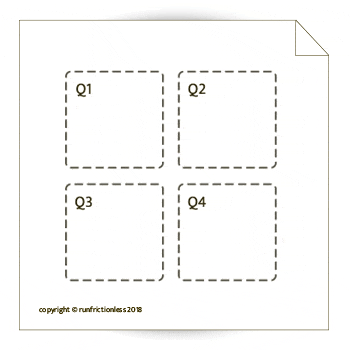
The 4Qs digital transformation framework is realistic. When you make a change in one part of the business, it will affect other parts of the business. For example, if you are standing in Quadrant 1, and wish to make a change, you are able to anticipate 🔔 the kind of change that will need to happen in Quadrants 3 and 4.
You can see who is assigned to Quadrants 3 and 4, and their processes. You can share with them why a change in Quadrant 1 will reduce friction across the organization, and agree on what resources management needs to approve to make the transformation possible.
Friction is not a sales problem or customer service problem. Nor is it a product problem. It is an organizational problem. Unless it is addressed across the business, friction is given a free hand.
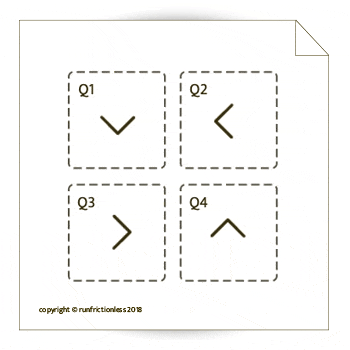
Michael Sribney and Peter Drube explain that making digital transformation is difficult.
The 4Qs digital transformation framework improves the odds of success by breaking down organizational barriers that prevent people from making decisions. Tim Wieringa, Transformation Partner, Hive17, rightly points out that by grouping executives and managers in one or more Quadrants, an organization can create an 😇 innovation team.
An innovation team is a virtual team that bridges functional silos within an organization. The bridge permits cross-functional decision-making and 💥 eliminates friction.
More on Tim’s insight later.
ABOUT THE 4QS DIGITAL TRANSFORMATION FRAMEWORK
The digital transformation framework is called 4Qs. There are four Quadrants. Within the Four Quadrants can be grouped as an organization’s people and processes.
Quadrant 1 addresses whom you serve. The remaining three Quadrants deal with what you are serving the customer, what you share in common with the customer, and what it feels like to become a customer of your business.
Create a picture of your 4Qs, as we explore each Quadrant in the coming chapters. Download the worksheet. Print the sheet and follow the assembly instructions.
The digital transformation framework does not 👌 lock users into a fixed starting point. Choose to begin a digital transformation in a Quadrant based on skill, interest, or where the business incurs the most friction.
For example, if you’re a product person you might commence transformation in Quadrant 2. A CEO might want you to start in Quadrant 3. DX purists are likely to start in Quadrant 4.
For the purposes of my demonstration, I’m going to begin in Quadrant 1 and move sequentially to Quadrant 4.
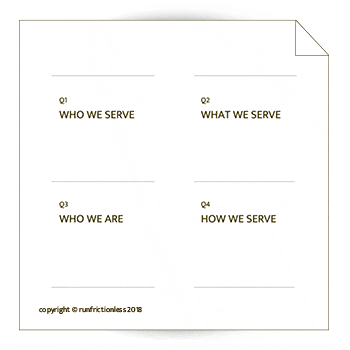
Quadrant 1 Who We Serve
Quadrant 1 addresses one of the most difficult questions any business must ask itself. Who do we serve?
This question can be addressed on three levels. Who do we serve today? Who do we serve tomorrow? And who do we absolutely never serve? That’s right. There are customer profiles that are liabilities and should remain unserved.
For many organizations, DX is about reconnecting with their existing customer profiles. Many executives are thinking 🤔 about how DX will provide a superior experience and enable them to reconnect with their existing customer. For example, banks realize their customer is on the go and travels often. It is getting difficult to attract this customer back to retail spaces.
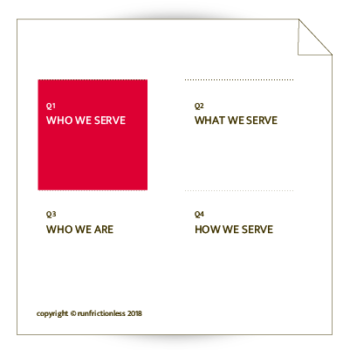
WHO WE SERVE TOMORROW
While some organizations are preoccupied with serving existing customers, other business leaders see DX as an opportunity to 🙌 look further afield. These organizations are using DX to unlock customers they serve tomorrow. Peter Drube, General Manager, DXC Technology, and Julian Seah, Income, Lead, Digital Transformation, both agree the opportunity is tomorrow’s customer.
Julian Seah has been a business leader in Southeast Asia for over 20 years. His specialty is taking digital products at varying stages of development, to a commercial scale. During our interview together, Julian and I figured out there were two ways one can use the digital transformation framework to find our 🌟 customer of tomorrow.
Customers who neither bought your product or competitor products can shape the profile of a customer who you serve tomorrow.
Customers who bought 🛍️ but complained are a rich source of intel. Data mining customers who complained about a product can extend beyond the organization and include competitors both indirect and direct. In organizations he has worked, Julian says these businesses settle customer complaints and then bury the data. Perhaps the pain of trudging through complaints to find insights is too stressful.
THE SUPERMARKET STORY
The Annam Group, a chain of supermarkets in Vietnam, are not so interested in how DX can improve their relationship with their existing customer. Instead, they are chasing customers who they can serve tomorrow.
Rather than improve the supermarket experience, the Group wants to 👏 digitize their warehouses and use e-commerce to reach customers living more than two-hours travel from the capital cities. These are people who may never have bought online. They may never have been exposed to this range of products before.
The Annam Group are clear ☝ about why they are digitally transforming and who the transformation will serve.
WHO WE NEVER SERVE
One of the challenges legacy organizations face is deciding who they ✋ never serve. Many organizations have gotten away with serving ‘anybody’. As long as there is revenue on the P+L statement, there’s no problem. This is no longer the case.
Customers are transforming too. Customers are consuming more digital experiences and expect personalized experiences. While digital transformation makes this possible, it does come at a cost. Either because the organization cannot offer a superior experience or because of the high cost to serve, there are customer profiles organizations should divest.
Lack of planning has exposed many organizations to startups that focus on serving 😉 fewer profiles, and offering a unique experience for each customer profile. More on Quadrant 1-4 fit later.
Gunter Haeussler says there are too few companies consciously deciding who they don’t serve. Instead, these organizations fumble through DX, trying to be all things to all people.
There may be customer profiles who do not share the new vision and digital transformation. For example, a profile may be fearful 😓 of cybersecurity. This profile refuses to adopt mobile, preferring traditional retail.
If we continue serving customers with whom we cannot offer a superior experience, we dilute the overall experience we are delivering and are more likely to attract 💔 negative reviews. We have to plan and anticipate what profiles are not likely to come with us on the journey.
One way to solve the problem is to channel these customers to partners or encourage them to move to a competitor and attract the customer back at a later date. When we get to Quadrant 4, we will discuss how the Timo Bank is using the later strategy to solve this problem.
In the meantime, let’s discuss how organizations can use partners.
THE MALAYSIAN BANK STORY
One of my criticisms of McKinsey’s digital transformation framework is that it expects an enterprise organization to behave 🤔 like a startup. A startup and enterprise organization are diametrically opposed. Enterprise is comparable to a large battleship – powerful but slow to steer. However, a battleship will always be a battleship. If agility is required, better to surround the battleship with a fleet of small destroyers.
This analogy has been adopted by banks. Since 2015, many banks from Malaysia have set up incubators to fund and support fintech startups. The banks give them access to data and resources, and in exchange, the fintech serve profiles where the bank cannot.
Where these organizations are not able to provide a superior experience, they use their ecosystem of fintech to serve the customer and figure out how to bring the fintech into the core business later.
The Standard Chartered Bank of Singapore began Standard Chartered Ventures. This is an avenue in which the organization can support intrapreneurs, who would otherwise leave and create a startup to serve a profile not served well by the bank.
CUSTOMERS YOU ARE COMPELLED TO SERVE
Some DX folk I spoke to saw Quadrant 1 as an opportunity to address 😲 internal customers. When you are working for a 1,000+ employee business, it stands to reason that not every staff member will have a direct customer. For many digital transformation projects, Tim Wieringa and Trevor Vella explain that customers are internal.
Tim Wieringa thinks the 4Qs digital transformation framework can work in an organization at 🙏 different levels. Each level of an organization can use the 4Qs from the beginning where value first begins until the value chain meets an external customer.
Peter Drube is a heavy DX hitter. I experienced countless ‘wow moments’ while interviewing Peter. Peter is General Manager of DXC Technology, Singapore. His DX experience in DX is very deep. He has worked in the Middle East and Africa, North America, Europe, and APAC. Peter’s domain expertise spans multiple industries including insurance, banking, telecommunications, transportation, manufacturing, and the public sector.
Peter takes Tim’s sentiments a step further. He encourages organizations to make their people consumers of their product. The idea is simple enough. Ask your people to consume the products and services you serve. As Peter put it:
This idea was rolled out by JustPayroll, a tech startup in the Philippines serving cloud payroll. It had a profound effect on product development. We now had an ‘internal customer’ who reported bugs faster than an external customer could.
Consulting firms Accenture and KPMG have done just that. For the last 15 years, Accenture has digitally transformed their business. Employees have the freedom to choose when, where, and how they work. There has been a reinvention of client relationship management. They now use more ✨ collaboration tools available in the cloud.
KPMG did a project with Rolodex Agency to increase awareness of digital transformation among its staff and partners. They developed a pop-up podcast studio where clients, staff, and experts could host discussions on the future of consulting.
Let’s look at Quadrant 2, and see how DX can help us get a Quadrant 1-2 fit.
QUADRANT 2 WHAT WE SERVE
Quadrant 2 👏 is where your transformation may begin. Quadrant 2 is what we serve. We serve the products and services we create in Quadrant 2 to the customers we serve from Quadrant 1. In this article, ‘product’ is synonymous with ‘services’.
If you served Sally 10 years ago, she may well have taken 30 days to choose where to open a savings account. Five years ago her decision was made in 10 days. Today, her decision is made in 72 hours.
With each year that passes, the window from Quadrants 2 to 1 doesn’t grow. It becomes smaller. This is because customers make buying decisions in a fraction of the time than they did before.
When organizations don’t achieve a Quadrant 1-2 fit, they often discontinue the product. This decision can be made prematurely.
Product owners don’t get on sales calls ☕ and they don’t visit customers. As long as they are producing products, they feel good. Instead, organizations traditionally fumble upon a Quadrant 1-2 fit by having salespeople pass second-hand intel to the product owner in the form of feedback. ‘Yes’ customers 👍 like your product. ‘No’ 👎 they hate it. The reasons for either are seldom understood.
Because product owners have no direct contact with customers, they never really ‘own’ the product. They have no context 🤔 to how the customer uses their product and the kinds of limitations they discover. Pretty soon, product owners begin building products in a vacuum.
They spend all their time in Quadrant 2, never giving a thought to Quadrant 1.
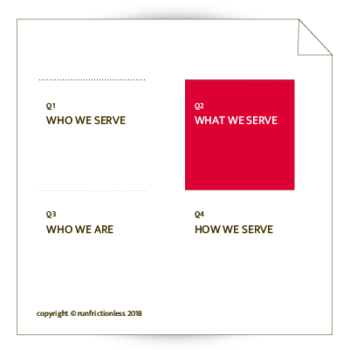
In fact, in most organizations I work with, there is no specification in Quadrant 1. The salespeople have not defined who they serve today, tomorrow, and never. This makes it difficult to achieve a Quadrant 1-2 fit.
DX provides an opportunity for product owners to get first-hand intel and make better decisions. For example, digital-first products bypass the salespeople who are intel gatekeepers. Instead, intel arrives directly into the hands 🙌 of the product owner.
Dan Pace, Provenio Partner, identified smart robotics as a means of accomplishing this feat. A smart robot is an artificial intelligence system that can learn from its users and develop solutions. Smart robots can collaborate with customers and product owners, learning from their behavior.
THE AUTO STORY
Auto manufacturers face a Quadrant 1-2 problem. They sell through resellers or dealerships. The manufacturer loses connectivity with Quadrant 1. No longer. Digital-first products can open up a direct relationship between the manufacturer and the car-owner.
How the customer uses the product and the limitations of the product can be directly communicated with the product owners. Khai Cao Nguyen, Digital Transformation, Mercedes-Benz Vietnam, explains that Mercedes’s introduction of the electric car in 2020, is paving the way for DX.
Khai may be a young man starting out in his career, but he is ambitious.
THE TELCO STORY
Adam Spence, Director of Digital Enablement, APAC, Verint, tells a story of product owners from a telco company in Australia. Many of the products created needed more work before going to the customer.
Adam explains, ‘No matter how much you transform the organization if the products have too much friction, all the gains from DX transformation are lost.’
There are often too many limitations in the product, meaning any efficiency ☝ gains from DX are eroded by the high number of limitations in the product. Customers avoid digital channels found on the internet and favor high-touch 🧨 contact points like a telephone to solve their problems.
In other words, these products are what Gunter Haeussler calls ‘products with digital wrappers’. These products are built with traditional thinking and traditional processes.
CapGemini’s digital transformation framework encourages organizations to go beyond digital wrapping traditional products, and instead build new products that are digitally native.
THE SANDBOX STORY
Trevor Vella takes DX in Quadrant 2 in a ☝different direction. Trevor believes DX often fails organizations because the customer is not involved in the early stages of product development. Trevor advocates getting a Quadrant 1-2 fit by asking real personas from Quadrant 1 to be part of mock-up testing before product build commences.
Trevor Vella has a unique approach, incorporating agile into his DX projects. Trevor has 25 years’ experience in information technology. His business, Netplanet Consulting, practices a mixture of professional leadership development, lean, and DevOps strategies. He has worked in government, enterprise, and startups, so he has seen all manner of transformation.
As part of DX, Trevor points out that self-service sandboxes are crucial tools for product owners and teams. Self-service sandboxes allow teams to rapidly prototype and test. Without self-service sandboxes, organizations face high costs for failure.
Peter Drube says more DX transformation would be successful if companies first culled ✂️ products from Q2. In a moment we will describe how DX can be used to intelligently serve the right product to the right customer profile.
QUADRANT 3 WHO WE ARE
It is true that customers from Quadrant 1 buy from Quadrant 2. They look at an organization’s product features, limitations, and workarounds. Customers then compare these with products offered by similar vendors and try to arrive at a rational buying decision.
In recent times, however, we have seen up to 70% of buying decisions not being made in Quadrant 2, but Quadrant 3. Quadrant 3 is important to digital transformation. From Quadrant 3, organizations tap into a customer’s irrational buying behavior.
Think of Quadrant 3 on ✌ two levels. The first level is rather superficial. It speaks to how well an organization brands each of its interactions. In legacy organizations, different departments often brand their interactions with customers differently. This inconsistency in branding introduces friction.
Why? The reason is simple. The packaging (Quadrant 3) is a cue ☝ to the quality of the product (Quadrant 2). The more consistent the packaging, the more likely the customer thinks the product is well-conceived and built.
When a company wants to transform, it is important to address this inconsistency, otherwise, DX perpetuates the same friction.
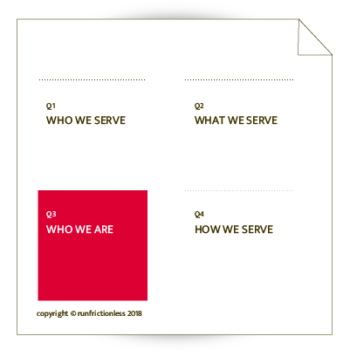
SHARING YOUR BELIEFS
Sharing beliefs will gather people to your transformation. Customers, staff, and shareholders will stand with you, talk, and share the belief as though it was theirs.
‘OMG. I’ve been telling people this for years. Finally, someone 👏 listened to me and changed the business.’ This kind of comment indicated you have struck a shared belief with staff.
Sharing beliefs address customers and staff alike because shared beliefs are inside-out. The people who serve the customer embody the belief. Shared beliefs start with the founder, infect shareholders, and staff, before attracting customers.
It is easy to dehumanize digital transformation, reducing it to technology and omitting a Quadrant 1-3 fit.
Of all four Quadrants, Quentin Ameziane said he liked to begin transformation in Quadrant 3. In fact, 35 percent of DX folk I interviewed said they would begin their 🤫 transformation in Quadrant 3.
Interestingly, Gartner’s digital transformation framework, like Accenture, puts shared beliefs first. They call stage one of their digital transformation framework ‘shared understanding’.
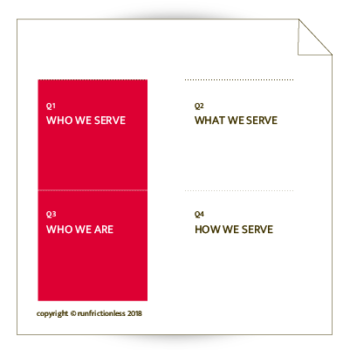
A RETAIL STORY
I remember a few years ago a CEO of a retail business announcing they would become 💥 agile. He’s been reading how other companies have become agile. He decided if they were agile, we need to be agile.
The CEO spent the next six months sharing his belief outside the company with prospects and customers, convincing them the organization was agile.
Here are a few problems which ensued.
Firstly, the culture of the retail company was perhaps not ready for a transformation. The organization did not reward staff for trying new ideas. Rather, it penalized. If your idea failed 👎, so did you. You may as well pack and leave because nobody would support you during your next project.
Secondly, while the CEO spent a lot of time sharing this belief outside the company, he spent ⌛ no time sharing his belief inside the company. Whenever they heard the CEO speak about agile, staff found it difficult to connect how agile translated to a benefit to customers.
Allen Pattiselanno, the founder of a DX consulting firm in Singapore, The Agile Donkeys, calls this kind of transformation, digital 💄 lipstick. Allen has nearly two decades of DX experience. Since the 1990s, Allen has worked on high profile clients from Singapore. Incidentally, Allen read my book titled, run_frictionless.
Don’t forget to read his review of the 4Qs digital transformation framework.
Allen borrowed the metaphor from the book title, Digital Lipstick on a Legacy Pig, Allen explains that many organizations treat DX as a veneer because they do not thoroughly understand it. Because digital transformation is difficult and all-encompassing, few businesses are doing digital transformation effectively.
Allen’s sentiments are not singular. Tristan Haentjens, a veteran of digital transformation, says ‘most digital transformation is a gimmick’. Peter Drube says most organizations that think they are undertaking digital transformation, are in fact making digital change. He stresses change plays a minor role whereas a transformation is a shift in the business model.
In a sense, the retail organization and its CEO had not given staff an objective. Transformation, in itself, was the objective.
Allen agrees with Peter. Allen boldly explains that it doesn’t help that technology companies sell technology, confusing customers.
Six months later the retail firm now had 🤫 digital lipstick kiosks. Digital transformation 🤞 complete. When customers contacted the organization, however, nothing had changed. Piercing the organization’s exterior, customers found themselves face to face with the same people, processes, and cultures from six months ago.
Technology companies are not the only entities falling foul of tech. Some digital transformation frameworks like one created by PwC, offer a digital smorgasbord. Business leaders are encouraged to pick what looks tasty and add it to their plate. Like Accenture, CapGemini places digital technology at the bottom suggesting it supports rather than leads.
Trevor Vella regards 🙌 shared beliefs from Quadrant 3 as crucial for transformation. Irrespective of the customer you decide to serve, what products you serve them, and how you serve, the decision about what belief to share is singular. In other words, while Quadrants 1,2, and 4 are ‘mapped’ against one another, Quadrant 3 cuts equally across all three Quadrants.
DX change management expert, Tim Wieringa, recognizes the importance of Q1-3 fit in his practice. When consulting with his customers, he calls shared beliefs the ‘collective dreaming’. Tim agrees that the shared beliefs are important because they give staff, customers, and shareholders a yardstick by which to measure all the decisions made in the remaining three Quadrants.
Tim’s input into Quadrant 3 and DXwas invaluable. Tim has six years of experience in delivering operational excellence through his business, Hive 17, Singapore. Before that he worked as an in-house transformation consultant for a number of years, at a chemical firm called Huntsman Singapore. Tim is passionate about DX and specializes in the change management of people.
Each of us can have a belief. The difference is, does anybody share 🙌 your belief? If your belief is not shared, you risk becoming isolated. You may even be labeled a crazy person, standing in a forest shouting about a subject no one can hear.
Allen warns that organizations that fail to convey the meaning behind DX, risk staff resisting change or worse, becoming saboteurs. Staff want digital transformation, but not at the expense of their job.
QUADRANT 4 HOW WE SERVE
For many, digital transformation begins in Quadrant 4. That’s because Quadrant 4 addresses how we serve a customer. Quadrant 4 sets out the precise set of interactions required to create a customer. DX often addresses how these interactions will move online.
Our research shows you can create a small business customer in 👌 10-15 interactions. If you are serving enterprise decision-makers, you need to support 25 up to 50 interactions.
Quadrant 4 also addresses what it ‘feels like’ to become a customer i.e. the customer experience. Research shows that there is a strong correlation between friction and customer experience. A reduction of friction improves the customer experience.
There are a series of fits that DX can help achieve.

We shall explore these in turn.
A FINANCE STORY
A financial consulting firm asked me to map a set of experiences from the moment a prospect made contact 🔔 with the sales organization, through to the moment they made a payment and became a customer. Once the set of interactions was codified and the cost of each interaction estimated, they were presented to the executive team.
The executives were astonished 😲 by the high cost to serve each customer profile. They were also concerned that the experience of becoming a customer was not memorable. The team decided to manage fewer interactions. The fewer interactions an organization manages, the less chance you introduce friction.
DX was able to collapse several interactions into a single interaction. Once DX was complete, the organization was able to reduce its overhead from 25 to 15 interactions – a far more manageable sum.
A Quadrant 1-4 fit can be achieved by managing fewer interactions. DX is very effective at reducing steps in a customer journey by digitizing experiences.
OLD SCHOOL
Telephone booking
Email reminder
Print and sign
NEW SCHOOL
Online booking
SMS reminder
Online signature
PERSONALIZED EXPERIENCES
Rather than having a single set of experiences for all profiles, each profile from Quadrant 1 is mapped a unique set of interactions. This gives the organization a Q1-4 fit. Research shows that customers who have a positive experience leading up to the purchase, rate ❤️ the product higher. DX can better match profiles in Quadrant 1 with relevant experience in Quadrant 4, even though the product served in Q2 is the same for all customer profiles.
Enterprise organizations have allowed startups to rise up against them, by serving all profiles the same set of experiences. Startups, with less mature products in quadrant 2, are winning business because unlike enterprise organizations, they have struck a tight Quadrant 1-4 fit.
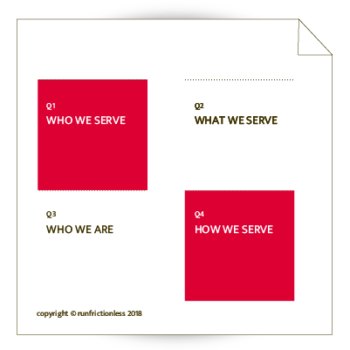
A VIETNAM BANK STORY
One such bank in Vietnam, Timo Bank, did just this to achieve a Quadrant 1-4 fit.
To understand the bank’s Quadrant 1-4 play, we first need to understand their business objective. The Bank decided to become the nation’s 🏆 top digital bank. The Bank figured out they could never deliver a superior experience in Quadrant 4, if they tried to serve both online and traditional banking. The cost to serve was too high.
So, in Quadrant 1 they ruthlessly decided not to serve customers in particular age brackets (let’s call them Group A), and focus on serving customers today who want an awesome online experience (Group B). Many of these traditional customers would leave and go to other banks, shifting 🤫 this ‘cost-to-serve’ to competitors.
Many of those that made up Group B were millennials. So the bank used digital transformation to create new online experiences in quadrant 4. They also closed their retail outlets and opened cafes instead. Here customers can present their cash cards and get free coffee.
In Quadrant 4 the Bank particularly wanted the glass barrier between the customer and service people removed. Timo cafes offered ATMs to do cash transactions and digital kiosks where Group B’s can book an appointment, let’s say for an account opening.
CUSTOMER EXPIRY
Time is an important dimension to making a buying decision. Every customer buying decision has an expiry. If the buying decision is not closed in the time frame, the customer is likely to drop off and abandon their buying decision.
BUYING DECISION
low involvement
high involvement
CUSTOMER EXPIRY
one hour
one year
CUSTOMER INTERACTIONS
5
24
If your customer expires in 14 days, and you design a set of experiences that are delivered in 21 days, you are out of the 👎 race. This is another Q1-4 fit that DX can address. DX provides an opportunity to serve customers before they expire.
Dan Pace takes customer expiry one step further. He thinks about expiry as not only part of acquiring a customer, but retaining them. In other words, how do you encourage a customer to buy, and keep buying? Dan explains that in the past he has successfully used predictive analytics to solve this problem.
UPSELL PRODUCT
Not all organizations have a single product. Many large organizations serve many products from Quadrant 2. This presents challenges. DX can help select the first product a profile should be served. Later, DX can intelligently instruct salespeople which products to serve next and when to best serve the product.
This is an example of DX helping large organizations get a Quadrant 1-2-4 fit. A specific profile mapped to a specific track in Quadrant 4, and intelligently served many products from Quadrant 2.
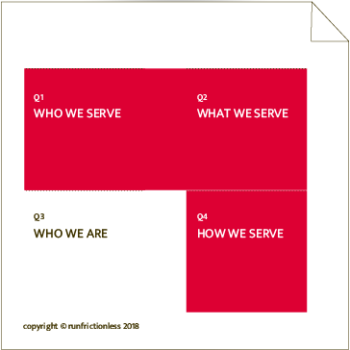
OPERATIONAL EXCELLENCE WITH THE 4Qs
During my discussion with DX practitioners, James McLaren, Director of Digital Transformation, Ultimum ICT, schooled 🙏 me on how the 4Qs is a means to achieve operational excellence. James founded Ultimum 18 years ago. His practice is located in Australia, but he reaches customers as far as Asia, the Americas, and Europe. He specializes in the financial sector. He has served some big names like Commonwealth Superannuation Corporation, Willis Towers Watson, IAG, NAB, Westpac Group, and, AMP.
I was delighted when James agreed to be interviewed. James says, ‘companies need operational improvement to push digital transformation. The 4Qs is an avenue to helping organizations achieve operational excellence’.
Cross-functional cooperation is essential to reaching 🏆 operational excellence. The 4Qs digital transformation framework gets cooperation from across an organization. The framework helps people in an organization talk about constraints, and therefore, together, they can better overcome 💪 these constraints.
Tim agrees with James. Tim once worked with an innovation team. The team consisted of people from marketing, product, operations, and sales heads. These four met regularly to collaborate. Tim says ”When you consider the 4Qs groups people and processes into one or more Quadrants, it is just a more organized version of this innovation team”.
In Gartner’s six-step digital transformation framework, Step 3 suggests why an organization should be supported by a 😇 digital excellence team. In fact, Jeanne Ross who wrote MIT’s digital transformation framework espouses downplaying functions.
Jean remarks, ‘Companies need to adopt a new framework of accountability organized around components rather than functions, product lines, or geographies’.

Different functional silos use different words when making decisions. These phrases often confuse 😖. The 4Qs digital transformation framework creates a simple, shared vocabulary. No matter whether people are from product, marketing, sales, or customer service, everyone understands the nature of the decision being made.
Marigo operational excellence in a different direction. Dr. Marigo Raftopoulos, Principal Consultant, Strategic Innovation Lab, is interested in how to better align the efforts of third-party vendors offering DX. They include ad agencies, UX-CX houses, and tech companies.
Dr. Raftopoulos explains the problem with service providers is that they are locked in functional silos. The 4Qs digital transformation framework is a way to get more value 🧨 from DX because service providers can work together in real-time.
Luke Evans is a business and digital transformation consultant from Australia. Luke has extensive DX and operations experience. He is concerned with how to get past a single transformation and reach a space where an organization can perpetually transform.
He explained that in order for DX to be successful, it must be ✊ perpetual. Luke Evans and Michael Sribney both believe that DX needs to come from the grassroots of an organization. Establishing an innovation team and making each member a custodian of a Quadrant is a step toward perpetual transformation.

grab the
whitepaper
FREE RESOURCES
ACKNOWLEDGMENTS
Special thanks to these DX practitioners for their time and brains. In no particular order. Trevor Vella, James McLaren, Michael Sribney, Peter Drube, Dan Pace, Quentin Ameziane, Tim Wieringa, Trieu Nguyen, Luke Evans, Julian Seah, Tristan Haentjens, Scott Rigby, Gunter Haeussler, James Rameriz, Adam Spence, David Bell, Mika Artaut, Claus Villumsen, Khai Cao Nguyen, Allen Pattiselanno, Khengwah Koh.

get started
using the
4Qs







